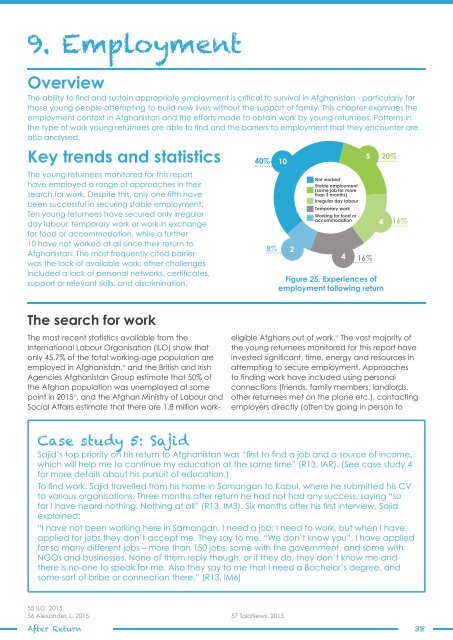After Return
After%20Return_RSN_April%202016
After%20Return_RSN_April%202016
You also want an ePaper? Increase the reach of your titles
YUMPU automatically turns print PDFs into web optimized ePapers that Google loves.
9. Employment<br />
Overview<br />
The ability to find and sustain appropriate employment is critical to survival in Afghanistan - particularly for<br />
those young people attempting to build new lives without the support of family. This chapter examines the<br />
employment context in Afghanistan and the efforts made to obtain work by young returnees. Patterns in<br />
the type of work young returnees are able to find and the barriers to employment that they encounter are<br />
also analysed.<br />
Key trends and statistics<br />
The young returnees monitored for this report<br />
have employed a range of approaches in their<br />
search for work. Despite this, only one fifth have<br />
been successful in securing stable employment.<br />
Ten young returnees have secured only irregular<br />
day labour, temporary work or work in exchange<br />
for food or accommodation, while a further<br />
10 have not worked at all since their return to<br />
Afghanistan. The most frequently cited barrier<br />
was the lack of available work; other challenges<br />
included a lack of personal networks, certificates,<br />
support or relevant skills, and discrimination.<br />
40%<br />
8%<br />
10<br />
2<br />
Not worked<br />
Stable employment<br />
(same job for more<br />
than 3 months)<br />
Irregular day labour<br />
Temporary work<br />
Working for food or<br />
accommodation<br />
4<br />
5<br />
16%<br />
Figure 25. Experiences of<br />
employment following return<br />
4<br />
20%<br />
16%<br />
The search for work<br />
The most recent statistics available from the<br />
International Labour Organisation (ILO) show that<br />
only 45.7% of the total working-age population are<br />
employed in Afghanistan, 55 and the British and Irish<br />
Agencies Afghanistan Group estimate that 50% of<br />
the Afghan population was unemployed at some<br />
point in 2015 56 . and the Afghan Ministry of Labour and<br />
Social Affairs estimate that there are 1.8 million work-<br />
eligible Afghans out of work. 57 The vast majority of<br />
the young returnees monitored for this report have<br />
invested significant, time, energy and resources in<br />
attempting to secure employment. Approaches<br />
to finding work have included using personal<br />
connections (friends, family members, landlords,<br />
other returnees met on the plane etc.), contacting<br />
employers directly (often by going in person to<br />
Case study 5: Sajid<br />
Sajid’s top priority on his return to Afghanistan was “first to find a job and a source of income,<br />
which will help me to continue my education at the same time” (R13, IAR). (See case study 4<br />
for more details about his pursuit of education.)<br />
To find work, Sajid travelled from his home in Samangan to Kabul, where he submitted his CV<br />
to various organisations. Three months after return he had not had any success, saying “so<br />
far I have heard nothing. Nothing at all” (R13, IM3). Six months after his first interview, Sajid<br />
explained:<br />
“I have not been working here in Samangan. I need a job; I need to work, but when I have<br />
applied for jobs they don’t accept me. They say to me, “We don’t know you”. I have applied<br />
for so many different jobs – more than 150 jobs, some with the government, and some with<br />
NGOs and businesses. None of them reply though, or if they do, they don’t know me and<br />
there is no-one to speak for me. Also they say to me that I need a Bachelor’s degree, and<br />
some sort of bribe or connection there.” (R13, IM6)<br />
55 ILO. 2015.<br />
56 Alexander, L. 2015.<br />
57 ToloNews. 2015.<br />
<strong>After</strong> <strong>Return</strong> 38


